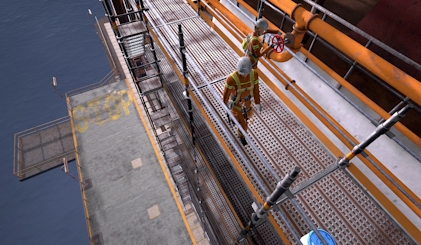Building a training module for your employees is never easy. To create an effective training module, employers must capture their employees' attention, transfer vast amounts of information in a retentive and innovative way, and ensure employees, upon completion, are prepared for the tasks at hand.
Fortunately for businesses everywhere, we know a thing or two about building immersive VR safety training content tailored to different industries and individual employees. Over the years, we have helped train thousands of employees from some of the biggest, boldest and brightest brands worldwide to make their workplace just a little safer through gaming.
If you’re attempting to create an effective training module that holds your employees’ attention and leaves them with the information they need to safely perform on the job, read about the four steps to build an engaging training module that resonates with employees below.
1. Embrace gamified learning
If you’re struggling to engage your employees effectively with your existing training content, consider a gamified module. After surveying thousands of trainees who have used Pixaera’s immersive modules, we found 98% of those surveyed preferred interactive experiential learning over traditional passive learning.
Emerging science has shown the power of flow and concentration when an individual is completely engaged in a task. By providing an immersive learning environment, we can stimulate all senses and activate a highly focused mental state that only occurs when an individual is completely absorbed in an assignment.
This concept is commonly referred to as “Flow State,” and was pioneered by psychologist Mihály Csíkszentmihályi. According to the E-Learning Industry, gamification in learning increases learner engagement, improves knowledge absorption and retention, sparks friendly competition, and safely facilitates mistake-driven learning. A University of Colorado study also found that those trained with video games have higher skills and retain information longer than those trained passively. So get creative! Gamify your training module to increase the skill set and improve retention of knowledge in your staff.
2. Use real data to create effective modules and define clear learning objectives
Creating effective training modules heavily relies on focus, credible sources and the ability to draw from real life experiences and problems. Using real problems experienced by real people while performing a certain task or job is crucial in defining clear learning objectives. It sets up a holistic game plan to address them head on in an interactive, meaningful and safe way. The more you understand the knowledge gaps in your team, the more you’ll be able to build immersive training modules that are tailored to the specific needs of your organization.
As an example, at Pixaera, we recently worked with a client who had a specific challenge they were facing in their workplace. Their injury statistics for the year highlighted that hands and fingers were the body parts most often injured at the company. They were kind enough to share the raw data with us, and after analyzing them, we identified the most common ways people got their hands hurt (e.g. doors, getting crushed by pipes, etc.). By incorporating this data, we were able to build a module around those exact scenarios based on real feedback and information, with a much greater impact, that effectively addressed the problem and met the needs of the client and their employees.
3. Involve the end-user, AKA the trainee, in the design process
Engaging employees in the design process is key to creating engaging and effective training modules. That's why when we design our modules like oil and gas VR training or VR manufacturing training, we seek input from our clients and their employees even before we begin any art or level design work. It enables us to gain valuable insights into what will increase engagement and knowledge retention during training.
What is it that your employees feel they need from their training? The best way to gather the information you are after is, first and foremost, by having a conversation with your department members and staff. Often, people like to be actively involved in the decision making process that affects their work, and are more than happy to share their views face-to-face. However, if for some reason, you are still missing important information or haven’t quite grasped the “big picture”, it is always an option to revert to a more streamlined approach such as;
- Surveys
- Focus groups
- Structured interviews
This employee input can then be used to improve every aspect of the module, from the art to the structure of the training. Only by utilizing key employee information, is it possible to create training modules that truly meet the needs and interests of the workers. It results not only in a more engaged and productive workforce, but also empowers employees to have a voice in the design of the training that is tailored to their needs. It's a win-win situation for both the employees and the company.
4. Constantly tweak and improve your module
As the builder of the training module, your work doesn’t end when the module is launched! Continue to seek feedback and constantly work to improve the module. Monitor training surveys to see if there are any persistent issues, and go back and address them in additional versions of the module. Also, monitor employees' scores to determine if sections of the training are difficult to understand and require revisiting. At Pixaera, we continually seek feedback on all our training modules to continually improve them when needed and make the best possible module for our clients.
Pixaera's VR training platform is the ultimate partner when it comes to building immersive, engaging training modules for your employees. If you’re designing a training module, embrace gamified training to increase employee engagement, use real data to help define your learning objectives, involve the end-user in the build process, and continue to refine your module once it’s launched.



